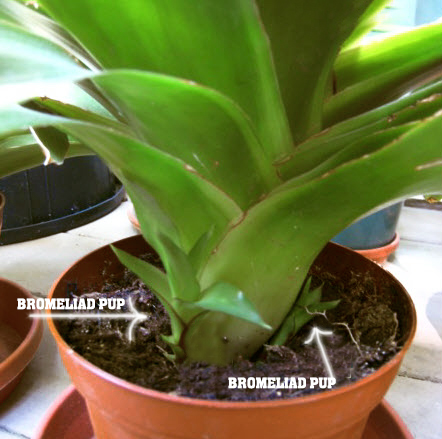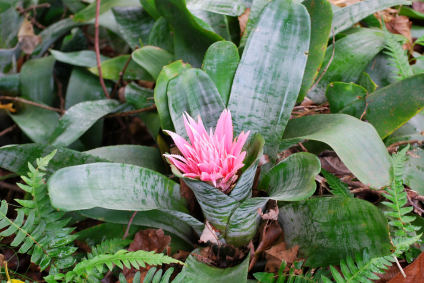Do You Have To Remove Bromeliad Pups
Beginner's Guide to Bromeliad Pups
Author: Melanie Dearringer
Care and Culture, Propagation

As sad equally it may seem, most bromeliads are one time bloomers. Your beautiful inflorescence will someday cease to be ornamental. Its bright color volition dull and eventually chocolate-brown. But before you toss your bromeliad in the trash, refusing to abound more attached to a found that is destined to die off regardless of the amount of care you provide it, there are some things you should know.
When a bromeliad plant reaches maturity information technology will stop producing leaves and the flower volition bloom into a beautiful, unique formation. At this point, the good for you bromeliad will produce offshoot plants from the base called pups. Pups are verbal clones of the female parent establish and are her style of continuing her legacy. So while the mother found is preparing for the inevitable, information technology is leaving yous with even more plants to intendance for in the future. Proper harvesting of the pups tin pb to numerous beautiful bromeliads and the potential for an ongoing generation of bromeliads for your enjoyment.
For more data on pups, check out our Complimentary Beginner'southward Guide to Bromeliad Propagation.
WHAT IS A BROMELIAD PUP?

-Bromeliad Pups
A pup is the offset of another bromeliad plant. Pups can form at anytime but this virtually oft occurs afterward your bromeliad has bloomed. One time a mature bromeliad reaches the bespeak where it has a healthy bloom and a strong core, the original plant (known as the mother) will stop producing leaves and will begin producing its next generation of plants. Pups will not reveal a bloom at this point but you lot will be able to place the cup forming as it grows upward from the base of the mother. It is possible to for the female parent found to have multiple offsets growing at the same fourth dimension. When these pups reach a certain size they can be harvested, planted, and cared for on their own. The female parent volition keep to thrive and produce additional offsets for the next year or 2.
Pups form on nearly all types of bromeliads. Propagation occurs in a like way for each of these different varieties.
WHEN AND HOW TO REMOVE BROMELIAD PUPS
The longer the pups are left fastened to the female parent plant, the faster they volition accomplish their ain maturity. Past leaving these offsets attached, they are able to take in nourishment from their mother, expediting their growth. Even so, removing the pups when they are smaller will allow the original bromeliad to focus the entirety if its free energy on throwing even more than pups. The choice on when to harvest is yours depending on your intentions.
Bromeliad pups can exist safely removed when they are i/iii to ane/ii the size of the mother plant. Some other expert indicator that the offsets can survive on their ain is the presence of roots. Root formation is not necessary for a pup to survive then don't be alarmed if they don't exist nevertheless.
Utilize a sharp, sterilized knife or pair of scissors to remove your new plant, cutting as shut to the mother plant as possible without injuring information technology. Sometimes there will be an outer leaf shielding the base of the pup. You can gently peel this leaf away to reveal the entire base of operations.
Once the pups have been removed, simply replace the soil effectually the mother found and it should go along to provide you with additional offsets.
HOW TO POT BROMELIAD OFFSETS
After the pup has been harvested from the mother, dip the cut ends in a fungicide and rooting hormone before potting it individually. Prepare a modest 4″ plant pot with a low-cal, well-draining medium. Because a pup's root system is express or non-real, you may discover the plant to be a niggling summit heavy with zippo to anchor it down. When placing your new constitute in within the pot take care not to ready it too securely in the potting mix in an effort to support its weight. Instead, use woods sticks or stakes to concord the institute up until it produces a root arrangement that is able to withstand its own weight.
CARING FOR PUPS

-Aechmea w. pinkish bracts
Light, warmth, and humidity are three important factors in growing salubrious bromeliads. This is axiomatic by their nature to grow in the hot climates around the equator and in other loftier moisture and hot temperatures regions. While newly potted pups bask bright indirect light, they require less low-cal than total grown, mature bromeliads. Exist sure to keep the new plants watered. It is best to keep the potting medium moist simply not wet. Over-watering bromeliad pups can cause rotting at the base of the constitute, which could atomic number 82 to a depression chance of survival at this disquisitional phase.
As the constitute becomes stable with its roots system you can remove the supports and permit it to showtime receiving more light. Provide the plant with some good light in the morning especially during the summer months. Shade for the residue of the day after the morning sun ordinarily leads to a good flower on a bromeliad.
Taking a bromeliad from the pup phase to total maturity is incredibly rewarding. It's a procedure that can be repeated over and over and takes approximately 2-3 years. With the proper knowledge and care, bromeliad propagation tin can be a great manner to build your drove.
Sources
Bromeliad Society International http://www.bsi.org/
Wikipedia http://en.wikipedia.org/wiki/Bromeliaceae

Do You Have To Remove Bromeliad Pups,
Source: https://www.bromeliads.info/beginners-guide-bromeliad-pups/
Posted by: colemanbethertine.blogspot.com


0 Response to "Do You Have To Remove Bromeliad Pups"
Post a Comment